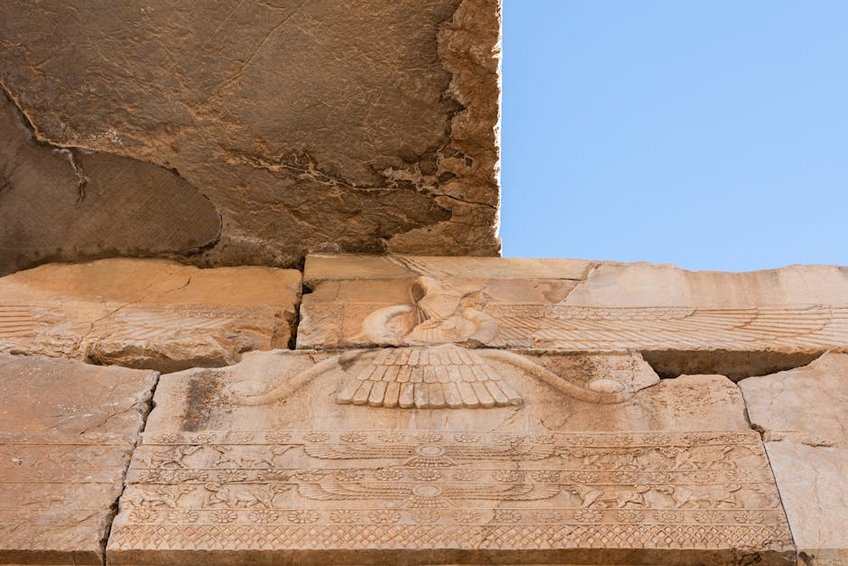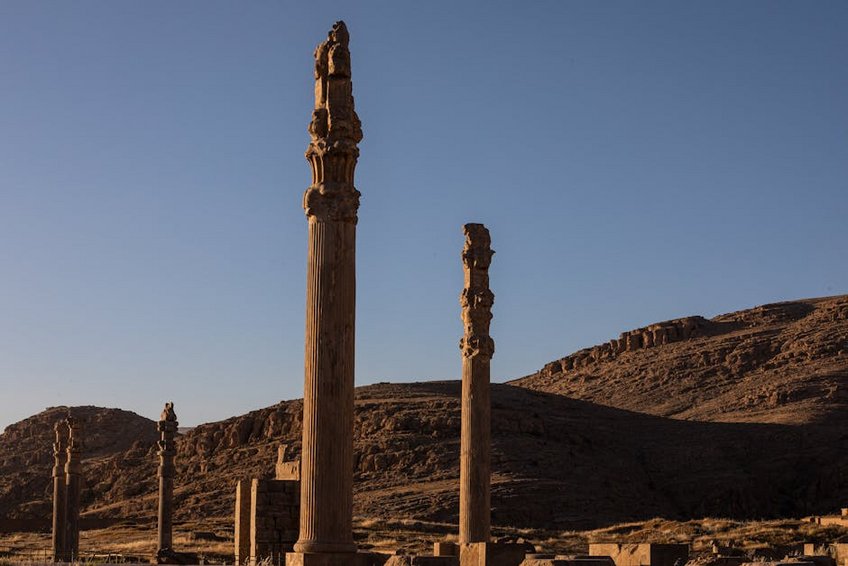Iran Persepolis Ancient Capital: Uncovering Persia’s Imperial Legacy
The Iran Persepolis Ancient Capital represents one of archaeology’s most significant sites, revealing the Achaemenid Empire’s architectural genius. Darius I established this ceremonial capital around 518 BCE, featuring monumental staircases and apadana halls that hosted delegations from twenty-three nations. This guide delivers practical visiting information, historical context, and cultural insights for Western travelers exploring this UNESCO treasure.
Persepolis Essential Historical Background
Persepolis served as the ceremonial capital for Achaemenid rulers from Darius I through Alexander the Great’s invasion. The complex covers approximately 125,000 square meters on the Marvdasht plain, engineered with sophisticated water management and construction techniques. Archaeologists continue uncovering artifacts that reshape understanding of ancient Persian administration and international relations.
French excavations beginning in the 1930s revealed the site’s original name Parsa, meaning “City of Persians.” Modern restoration efforts carefully preserve the delicate bas-reliefs depicting subject nations bringing tribute to the king. These artistic representations provide invaluable evidence of Achaemenid imperial ideology and multicultural tolerance.
Key Historical Timeline – What You Need to Know
Understanding Persepolis’ chronology enhances appreciation of its architectural evolution.
- 518-515 BCE: Darius I initiates construction of terrace, apadana, and main palaces using innovative stone-cutting techniques.
- 486-465 BCE: Xerxes I expands complex with Gate of All Nations and his own palace, adding monumental inscriptions.
- 330 BCE: Alexander the Great’s army partially destroys the capital during occupation, though debate continues about accidental versus intentional burning.
- Budget tours at $1,200-1,800 include basic hotels, group transportation, and essential site entries with government-required guides.
- Mid-range options costing $2,000-3,000 provide better hotels, specialized archaeological guides, and included domestic flights from Tehran to Shiraz.
- Premium experiences at $3,500-5,000 feature luxury accommodations, expert English-speaking guides, and special access permissions for photography.
- UNESCO World Heritage Centre – Persepolis
- Lonely Planet Persepolis Travel Guide
UNESCO World Heritage Significance
UNESCO designated Persepolis a World Heritage site in 1979, recognizing its outstanding universal value. The organization cites the site’s exceptional testimony to Achaemenid civilization and architectural masterpiece status. Preservation protocols now limit visitor access to certain areas to prevent erosion of delicate stone surfaces.
International conservation teams collaborate with Iranian experts using non-invasive technologies for documentation. Digital mapping projects create 3D models that aid both preservation efforts and virtual accessibility. These initiatives ensure future generations can study this remarkable ancient Persian capital.
Geographical Context and Regional Connections
Persepolis occupies the Marvdasht plain northeast of Shiraz in Fars Province, positioned at 1,800 meters elevation. The location offered strategic advantages with natural defenses and proximity to the Pulvar River. Nearby sites include Naqsh-e Rustam with its royal tombs and Pasargadae, Cyrus the Great’s capital.
The region experiences semi-arid climate with hot summers and mild winters, affecting preservation conditions. Modern access routes follow ancient paths connecting the Persian heartland to Susa and other imperial centers. This geographical positioning reinforced the Achaemenid vision of unified territory.
Iran Persepolis Ancient Capital – Planning Your Archaeological Visit
Western travelers need careful preparation for visiting this Iranian archaeological treasure. United States passport holders must obtain visas through the Iranian Interests Section at the Pakistani Embassy in Washington DC. European Union citizens can apply through Iranian consulates, typically requiring guided tour arrangements.
The ideal visiting window falls between March and May when daytime temperatures range 65-80°F (18-27°C) with minimal rainfall. September through November offers similar conditions with comfortable exploration weather. Summer months reach extreme heat exceeding 100°F (38°C), complicating extended outdoor site visits.
Budget approximately $1,500-2,500 for a comprehensive 10-day Iran itinerary including Persepolis. This covers mid-range hotels, licensed guides, domestic flights, and entrance fees. Independent travel remains challenging due to visa restrictions requiring organized tours for most Western nationals.
Best Time to Visit Persepolis
March through May delivers ideal conditions with mild temperatures between 60-75°F (16-24°C) and blooming spring vegetation. These months avoid both summer’s intense heat and winter’s occasional rainfall, providing optimal photography light. The Nowruz Persian New Year period in late March brings larger domestic crowds.
September to November offers similar advantages with temperatures 65-80°F (18-27°C) and clearer autumn skies. Visiting during weekdays minimizes contact with weekend domestic tourists. Morning hours before 10 AM provide the best photography conditions with softer shadows on relief carvings.
Budget Planning and Archaeological Tour Costs
Iran travel costs vary significantly based on tour style and accommodation preferences.
Essential Preparation Checklist
Pack conservative clothing including headscarves for women, loose-fitting pants, and long-sleeved shirts respecting Islamic dress codes. Bring comfortable walking shoes with good traction for uneven stone surfaces and sun protection like hats and sunscreen. Photography equipment should include polarizing filters to reduce glare on stone surfaces.
Secure comprehensive travel insurance covering Iran, all necessary medications with original packaging, and multiple payment methods. US credit cards don’t function in Iran, so bring sufficient cash in euros or US dollars for additional expenses. Download offline maps and translation apps since internet access may be limited.

Alt: “persepolis-achaemenid-architecture-bas-relief-details”
Top Archaeological Sites and Exploration Activities
Persepolis reveals its grandeur through multiple monumental structures spread across the vast terrace. The Gate of All Nations with its colossal winged bull figures welcomes visitors into the ceremonial complex. Beyond lies the Apadana Palace where twenty-three subject nations carved their delegations bringing tribute.
The Treasury building stored imperial wealth while the Hundred-Column Hall served as throne room and reception area. Each structure features unique architectural elements and inscriptions in Old Persian, Elamite, and Babylonian cuneiform. Allow at least four hours to appreciate the site’s scale and detail.
Must-See Monumental Highlights
The Apadana Stairway’s eastern facade displays perfect preservation of tribute procession reliefs. These detailed carvings show delegates from across the empire bringing gifts, each with distinctive ethnic clothing and offerings. The precision of these 2,500-year-old sculptures demonstrates exceptional Achaemenid artistic achievement.
Darius the Great’s palace (Tachara) features exquisite stonework and window frames inscribed with his name. The Central Palace shows architectural evolution under different rulers with blended styles. Climb the hills behind the terrace for panoramic views of the entire complex against mountain backdrop.
Hidden Gems and Less-Crowded Areas
The Unfinished Gate reveals construction techniques with partially completed columns and doorways. This area receives fewer visitors but provides unique insight into Achaemenid building methods. Nearby, the Royal Tombs of Artaxerxes II and III offer quieter contemplation spaces with valley views.
The Museum housed in the harem building displays artifacts from excavations including ceremonial vessels and clay tablets. This air-conditioned space provides relief from heat while showcasing small finds from the site. The surrounding garden features reconstructed column elements helping visualize original structures.
Guided Tours Versus Independent Exploration
Licensed guides provide essential historical context and translation of cuneiform inscriptions. Their expertise helps visitors understand complex iconography and architectural significance. Many quality guides operate through registered tour companies in Shiraz.
Independent exploration allows flexible pacing and photography opportunities. However, regulations often require accompaniment by official guides for Western visitors. Audio guide rentals available at the entrance offer reasonable alternative for those preferring self-guided experiences.
Practical Travel Logistics and Accommodation
Most international travelers reach Persepolis via Shiraz, Iran’s cultural capital with international airport connections. Fly into Shiraz International Airport (SYZ) from Istanbul, Dubai, or Doha, then drive sixty minutes northeast to the site. Domestic flights from Tehran to Shiraz operate frequently with one-hour flight duration.
Shiraz offers accommodation ranging from budget guesthouses to international-standard hotels. The central areas near Karim Khan Citadel provide convenient access to restaurants and tour operators. Pre-booking through licensed tour companies ensures compliance with visa requirements for Western passport holders.
| Accommodation Type | Features and Location | Price Range (USD) |
|---|---|---|
| Budget Guesthouses | Basic rooms, shared bathrooms, central Shiraz locations | $25-45 nightly |
| Mid-Range Hotels | Private facilities, restaurant, tour desk services | $60-100 nightly |
| Boutique Properties | Traditional architecture, courtyard gardens, premium amenities | $120-200 nightly |
| Luxury International | Swimming pools, multiple dining, business facilities | $220-350 nightly |


